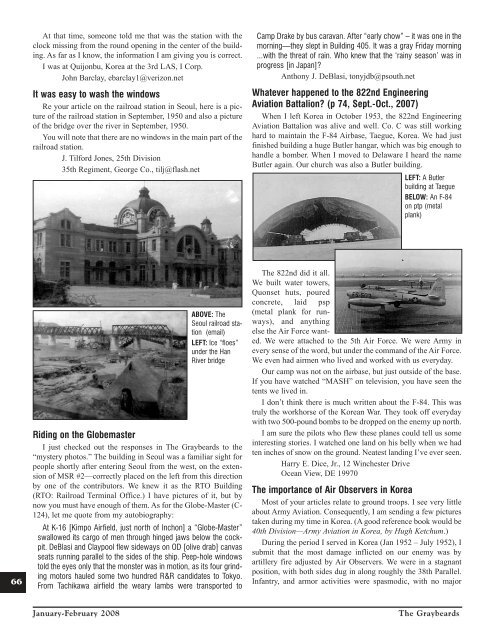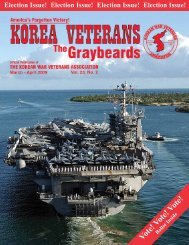Jan/Feb 2008 - KWVA - Korean War Veterans Association
Jan/Feb 2008 - KWVA - Korean War Veterans Association
Jan/Feb 2008 - KWVA - Korean War Veterans Association
Create successful ePaper yourself
Turn your PDF publications into a flip-book with our unique Google optimized e-Paper software.
At that time, someone told me that was the station with the<br />
clock missing from the round opening in the center of the building.<br />
As far as I know, the information I am giving you is correct.<br />
I was at Quijonbu, Korea at the 3rd LAS, I Corp.<br />
John Barclay, ebarclay1@verizon.net<br />
It was easy to wash the windows<br />
Re your article on the railroad station in Seoul, here is a picture<br />
of the railroad station in September, 1950 and also a picture<br />
of the bridge over the river in September, 1950.<br />
You will note that there are no windows in the main part of the<br />
railroad station.<br />
J. Tilford Jones, 25th Division<br />
35th Regiment, George Co., tilj@flash.net<br />
Camp Drake by bus caravan. After “early chow” – it was one in the<br />
morning—they slept in Building 405. It was a gray Friday morning<br />
...with the threat of rain. Who knew that the ‘rainy season’ was in<br />
progress [in Japan]?<br />
Anthony J. DeBlasi, tonyjdb@psouth.net<br />
Whatever happened to the 822nd Engineering<br />
Aviation Battalion? (p 74, Sept.-Oct., 2007)<br />
When I left Korea in October 1953, the 822nd Engineering<br />
Aviation Battalion was alive and well. Co. C was still working<br />
hard to maintain the F-84 Airbase, Taegue, Korea. We had just<br />
finished building a huge Butler hangar, which was big enough to<br />
handle a bomber. When I moved to Delaware I heard the name<br />
Butler again. Our church was also a Butler building.<br />
LEFT: A Butler<br />
building at Taegue<br />
BELOW: An F-84<br />
on ptp (metal<br />
plank)<br />
66<br />
ABOVE: The<br />
Seoul railroad station<br />
(email)<br />
LEFT: Ice “floes”<br />
under the Han<br />
River bridge<br />
Riding on the Globemaster<br />
I just checked out the responses in The Graybeards to the<br />
“mystery photos.” The building in Seoul was a familiar sight for<br />
people shortly after entering Seoul from the west, on the extension<br />
of MSR #2—correctly placed on the left from this direction<br />
by one of the contributors. We knew it as the RTO Building<br />
(RTO: Railroad Terminal Office.) I have pictures of it, but by<br />
now you must have enough of them. As for the Globe-Master (C-<br />
124), let me quote from my autobiography:<br />
At K-16 [Kimpo Airfield, just north of Inchon] a “Globe-Master”<br />
swallowed its cargo of men through hinged jaws below the cockpit.<br />
DeBlasi and Claypool flew sideways on OD [olive drab] canvas<br />
seats running parallel to the sides of the ship. Peep-hole windows<br />
told the eyes only that the monster was in motion, as its four grinding<br />
motors hauled some two hundred R&R candidates to Tokyo.<br />
From Tachikawa airfield the weary lambs were transported to<br />
The 822nd did it all.<br />
We built water towers,<br />
Quonset huts, poured<br />
concrete, laid psp<br />
(metal plank for runways),<br />
and anything<br />
else the Air Force wanted.<br />
We were attached to the 5th Air Force. We were Army in<br />
every sense of the word, but under the command of the Air Force.<br />
We even had airmen who lived and worked with us everyday.<br />
Our camp was not on the airbase, but just outside of the base.<br />
If you have watched “MASH” on television, you have seen the<br />
tents we lived in.<br />
I don’t think there is much written about the F-84. This was<br />
truly the workhorse of the <strong>Korean</strong> <strong>War</strong>. They took off everyday<br />
with two 500-pound bombs to be dropped on the enemy up north.<br />
I am sure the pilots who flew these planes could tell us some<br />
interesting stories. I watched one land on his belly when we had<br />
ten inches of snow on the ground. Neatest landing I’ve ever seen.<br />
Harry E. Dice, Jr., 12 Winchester Drive<br />
Ocean View, DE 19970<br />
The importance of Air Observers in Korea<br />
Most of your articles relate to ground troops. I see very little<br />
about Army Aviation. Consequently, I am sending a few pictures<br />
taken during my time in Korea. (A good reference book would be<br />
40th Division—Army Aviation in Korea, by Hugh Ketchum.)<br />
During the period I served in Korea (<strong>Jan</strong> 1952 – July 1952), I<br />
submit that the most damage inflicted on our enemy was by<br />
artillery fire adjusted by Air Observers. We were in a stagnant<br />
position, with both sides dug in along roughly the 38th Parallel.<br />
Infantry, and armor activities were spasmodic, with no major<br />
<strong>Jan</strong>uary-<strong>Feb</strong>ruary <strong>2008</strong><br />
The Graybeards
















